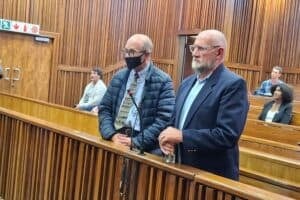60 years since Rivonia trial: A nation reflects on sacrifices, as courtroom becomes important history lesson.

With Rivonia treason triallists no longer alive to recount paying a supreme sacrifice through long jail terms on Robben Island for South Africa to be free from apartheid, the country yesterday relived the 60th anniversary of the court case that shook the world.
In what went down as a historic marking of the treason trial, which ended in Judge Quartus de Wet, on 12 June, 1964, sentencing Nelson Mandela, Dennis Goldberg, Walter Sisulu, Govan Mbeki, James Kantor, Andrew Mlangeni, Elias Motsoaledi and Raymond Mhlaba to life imprisonment for sabotage, the Ahmed Kathrada Foundation hosted a moving enactment of parts of the case.
ALSO READ: Apartheid victims march after waiting decades for restitution
While De Wet and chief prosecutor Percy Yutar did not live long enough to witness Mandela’s brave efforts which led to the birth of South Africa’s constitutional democracy, the famous Court C at the Palace of Justice in Pretoria’s Church Square was transformed into a history lesson on the country’s painful past.
Mandela’s speech
In what went down as the most profound moment in the trial 60 years ago, Mandela made a speech in the dock in which he condemned the court in which he was appearing as “illegitimate”.
The packed courtroom of the post-democratic South Africa was attended by judges Jody Kollapen, Dunston Mlambo, AP Ledwaba and Sisulu’s eldest son Max and wife Elinor. It marked the day with speeches and the enactment of the trial by a youth group.
The largely youthful audience had an opportunity to visit the dingy underground holding cells where Mandela and his comrades were held before being transferred to Robben Island.
With the white paint having peeled off the walls, there were some visible hand-written messages by the triallists, which included an excerpt from the Freedom Charter.
“There shall be houses”, “Dream is to be free”, and “ANC”, were among the inscriptions on the walls.
ALSO READ: Inquest into deaths of Luthuli, Mxenge and Mantyi to be reopened, says Lamola
Reflecting on the significance of the event, Kollapen said: “The moment allows us as a nation to go back 60 years, unpack what happened in this courtroom and understand why our leaders were in the dock.
“They were there for one reason only – collectively to fight for freedom and justice all South Africans, not for whites or blacks. This court is historic because it was the main court used by the apartheid state.
“The Rivonia trial was in this court, the Delmas treason trial was here and the Saso-BPC [SA Students’ Organisation-Black People’s Convention] trial was here in the Palace of Justice.”
Kollapen said over the years, the accused engraved their names on the wooden benches, with the dock representing something historic.
“It is a court we should try to preserve, so that young people can visit here and see the charge sheet and pictures. Maybe it should no longer be used as a functioning court.”
Ahmed Kathrada Foundation director Neeshan Bolton said Rivonia represented “a trial of people who had everything to lose – facing a death sentence”.
ALSO READ: There is much to ‘celebrate’ in South Africa
He added: “In the pursuit of freedom, they were prepared to accept the death sentence.
“When I contrast this with the leadership of today, current leaders have an expectation of rewards.
“The Mandela and Kathrada leadership had no expectation of any reward. This was a trial of extreme courage, across colour, race and age – signifying an important lesson for South Africa today.”
Bolton said solutions to SA required the involvement and sacrifices of people across all walks of life. “No one group will solve issues of South Africa on their own.
“While still a functioning court, I am happy that we were allowed the opportunity to use it. With dedicated people and resources, this court should be used as a centre of learning.”






